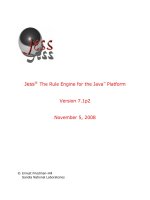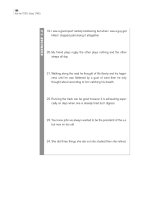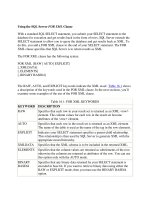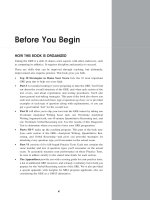Tài liệu Study the Values--Higher Values For You ppt
Bạn đang xem bản rút gọn của tài liệu. Xem và tải ngay bản đầy đủ của tài liệu tại đây (159.13 KB, 23 trang )
Study the Values
Higher Values For You
Not too long ago, on a hot, summer night, I took my family to a quick-serve
restaurant, a franchise known for its ice cream. The place was dirty. Service
was slow. Other customers stacked up behind us. Finally, somebody took our
order, and we experienced another long delay while sitting at a table that had
not been recently wiped. The employees did not seem to care that we and
others were waiting. We could hear them talking in back somewhere. A few
other customers, frustrated with the wait, left before being served. When we
finally got our treats, we ate them hastily, a nice evening gone flat. A few
months later, the city tore up the street at that intersection. The construction
caused temporary problems for all the surrounding businesses, but this
restaurant closed permanently. The franchisee complained in the local
newspaper that "the city" had put him out of business. I remember thinking
that what put him out of business was having the most unappealing eatery
and the worst service in town.
You see this kind of thing in retail all too often—a disconnect between the
promise of the retail brand and its execution. Mediocre service and dirty
tables do not make for happy customers. Sometimes the disconnects are
accidental or unforeseeable. Perhaps that restaurant had people call in sick
and the crew was worn out near the end of a double shift. (Couldn't they at
least have given us a frazzled smile?) More often, poor results come from a
superficial understanding of brand, or wishful thinking, or plain laziness.
You cannot promise quality and follow through with half-hearted execution.
I wonder how many times that franchise owner—the one so angry at the city
—checked on his store at odd times to see what was happening. I wonder
whether he ever did a reality check on his operations after his sales started to
slide, which I suspect was long before the street reconstruction began.
What we saw as customers that night was a brand breakdown. Every
breakdown in brand occurs because of a lack of corporate values or an
Internal Broadcasting Nguyen Chi Thanh
Study the Values
insufficient effort to execute on those values. This chapter begins with a brief
discussion of brand, follows by relating the brand to core values, and shows
how core values are instrumental in a retailer ideating a compelling concept,
developing a meaningful mission statement, and creating a compelling
customer experience out of that mission.
"Brand" is a complex subject issue because for retailers the "brand" consists
of both the brand image of the products being sold and the brand
presentation of the store itself. For a retail concept that sells only or primarily
its own brand of products—Armani clothing, Starbucks coffee, or Goodyear
tires, for example—the situation is simpler, but the overall retail brand still
has two elements: the quality level and packaging of what is being sold and
how it is being presented and sold within the four-wall retail environment.
Most brand discussions focus only on what is being sold—products—rather
than the manner in which the products are offered to the public. Even here,
the brand discussion often degenerates into superficial or temporary aspects
of brand, such as the creativeness of the logo, the freshness of the packaging,
or the jazziness of the ad campaigns. This approach trivializes the basis of a
product brand and does not begin to grapple with the concept of brand as it
relates to retailing.
For these reasons, it is necessary to briefly define brand as it relates to both
product and retailiang and to discuss the issues that affect both.
For a product and for a product company, "brand" is the product or corporate
image, the positioning asserted in various marketing campaigns and
supported by product quality, customer service, and overall business
behavior. A retail brand builds on these same elements, benefiting from the
quality and the features of the products, the packaging, and related product
marketing. The retailer's overall business behavior also shapes the customer's
perception about the brand. However, the retail brand is so much more than
any of these individual elements. Brand is the design and presentation of
your building. It is whether you can deliver the product in a timely and
consistent way. It is your company policy on returns and exchanges. (This
includes how easy and pleasant it is for customers to engage with store
Internal Broadcasting Nguyen Chi Thanh
Study the Values
personnel to make the exchange.) It is whether your store has parking and
whether, if it supports your positioning, you pay for validated parking. It is
the comfort level of your store when customers shop. It is your employees
and their attitudes. It is how they dress and whether they smile. It is whether
they know when to assist and when to let the customer browse. It is their
knowledge about your products. When customers leave the store, it is
whether employees say "thank you" in a way that makes customers feel
appreciated. Ultimately, a product brand comes down to the customer's belief
in the quality or the value of the product. A retail brand comes down to the
overall experience of the customer in the store, of which product quality or
value is only one part.
For long-term success, all of the attributes of a product brand must be
aligned, but a strong positive image for a product can create a "grace" period
in the public's mind. Corporate image can carry a product company for a
while when its products trail those of competitors, and product quality can
carry the company for a while when its corporate image is less than perfect.
Because the retail brand rests upon an actual, personal, encompassing
experience, however, no one element can "carry" all the others. The potential
buyer comes face to face with every aspect of the brand at once. Store design
and appearance, product quality and presentation, and customer service will
overwhelm any brand impressions the customer might have had before
entering into the establishment. For retailers, the store experience is the
brand. Because the customer is there, in the store, the reaction to any
slippage in any brand attribute is immediate. The ice cream store failed on its
appearance and service, so our confidence in the brand collapsed in a single
visit, despite its fine products.
Even more than with an individual product, a brand attribute for a store is not
something you can slap on, a sticker that proclaims "high quality." Whatever
you assert, the customer has to merely look around to decide whether you
meet your promise. Brand does mean a unique positioning—the best, the
brightest, the fastest, the "something" that nobody else has. But that
something has to come from within, not from "without." Just as a product
brand cannot long retain credibility by shouting, "New and improved!" if the
Internal Broadcasting Nguyen Chi Thanh
Study the Values
product is old and unchanged, neither can a retailer long survive with
advertising proclaiming the latest fashion trends if the clothing line has the
same styles season after season. Maybe the hard truth is that your only
unique positioning is that old Mad Magazine maxim—"Our price, cheap"—
but at least the positioning is an honest one. Whatever claim you make for
your brand, it must be an intrinsic part of who you are as a product company
or retailer.
To become a powerful brand, every retail concept must be based on strong,
core personal values and business values. Because of the personal nature of
retail and the customer's direct presence, you cannot fake who you are and
what you stand for. As you look to create a new retail brand or to invigorate
an existing one, you must look inside to your own ideas and standards. Make
no little plans, and have no small values. The word "value," as used in
branding, can mean either principles (of the business person or company) or
worth (to the customer, as in the value proposition). Here, "core value"
means a blend of the two because your worth to the customer must spring
directly from your principles. Personal honesty and honest treatment of your
customer are two sides of the same coin.
Each exciting, new concept begins with ideation—idea generation—and the
first step in idea generation is to determine these core values. Without
building on your own core values, it is highly unlikely that you will create a
concept that differs from a dozen other similar concepts that are already out
there. Basing the concept on a core value provides a fundamental and
sustainable differentiation. The difference is not in a transient value, such as
the flash of a particular marketing program, or even in the particular product
you sell, however good it may be. It is in the way you run your business,
which, in turn, determines the product you sell and also the other attributes
of business (brand!) that you embody. Core values lead to corporate values.
Corporate values lead to product and store values. Product and store values
lead to store branding. Store branding leads to corporate branding. Corporate
branding reinforces corporate values. All of these ideas roll one into the
other to create a self-perpetuating wheel of value, action, and perception. A
Internal Broadcasting Nguyen Chi Thanh
Study the Values
specific example helps illustrate how core values pertain to both product and
retail branding.
The adidas sports brand takes its values from its founder, Adi Dassler, an
athlete who played soccer well into his 60s and who spent his entire life
creating equipment for athletes. Beginning with his first hand-made shoe in
1920, Adi personally created the category of athletic shoe. He made the first
spiked track shoe; the first screw-in cleats, which helped Germany claim a
World Cup victory on a muddy field; the first bobsled shoe; the first ski-
jump boot; and the first ultralight sprint shoe, among many other inventions.
Once, while watching the Montreal Olympics from home in Germany, he
called Alberto Juantoreno and advised him to reposition his spikes to avoid
drifting around the turns—a problem Adi had noticed on television—and the
Cuban runner became the first person to win gold medals in both the 400-
meter and 800-meter run.
Adi's passion for athletes carries through in adidas's innovation and brand
positioning today. With more than 700 patents on sports equipment, adidas's
focus remains on athletes and equipment that makes athletes better
performers, whether this is a new design for a soccer ball or a special shoe
for high jumpers. In the company's retail stores, these values are celebrated
in a dual-store format. One concept is the Heritage store, the smaller of the
two concepts at about 4,000 square feet. These stores feature several iconic
displays, such as historical prototypes of some of Adi's shoes, to ensure that
the company's legacy is communicated at the retail level. The other brand-
defining concept is the large-store format, at between 12,000 to 25,000
square feet. These stores feature breadth and depth, the company's complete
line of equipment and clothing in all sports, which range from track and field
to soccer to golf to snow sports. In both formats, store personnel offer
technical expertise to complement the company's background and to ensure a
positive store experience for the customer and a position of category
leadership.
Figure 1-1 The heritage of Adi Dassler, who invented an athletic shoe for
almost every category of competition, led to the creation of the first
Internal Broadcasting Nguyen Chi Thanh
Study the Values
legitimate sports brand in the world, adidas, and to one of the most
recognizable logos, the adidas trefoil (top). The solid grounding of the brand
in the company's mission and corporate values has helped the company
continue to innovate for more than 80 years. The company's brand strength
has led to natural brand and logo extensions into high-performance gear
(center) and lifestyle-fashion gear (bottom).
For the retailer especially, branding really does go back to its original sense
of imprinting. Brand is every way you touch the customer, and branding is
the overall personal experience your customer has with you. The slick
aspects of packaging, ads, logos, store signs—all the visual, sensual stuff—
summon up those experiences, but they cannot replace the experience itself.
Neither can a good product make up for a poor in-store experience. If the
experiences are good, the logo (as one example) becomes an icon that draws
customers. If the experiences are poor, the logo deflects customers toward
the competition. Retail is about the here and now, the quality of the
experience today. The power of the retail experience is why many product
brands would love to have a direct experience with the customer, rather than
relying on another company to present the brand to the public. The power of
the retail experience is why many product brands, from shoes to clothing to
computers, open their own shops after testing their concepts within another
company's retail shops to determine their differentiating factors and the
"sweet spot" for both pricing and presentation. The power of retailing is why
a number of companies that sell primarily through other retailers also open
their own stores. In addition to emphasizing the company's history and
showing customers the full range of the brand's products, for instance, the
adidas's retail stores also demonstrate to other resellers of their products
unique ways to merchandise them.
In contrast, the power of the retail experience is why even one poor store can
be so damaging to the brand. The ice cream shop where we stopped that one
summer night was just one outlet of the many 100s of good ones around the
country, but the experience has remained. To this day, we generally choose
another stop for our dessert. Because of my work, I may have a sharper eye
Internal Broadcasting Nguyen Chi Thanh
Study the Values
than most, but my kids are the ones who made the decision not to return to
this company's stores.
Clearly, the operator of this one store did not carry within himself the values
that the franchise attempted to create nationally. Likewise, the operator of
the store evidently made no effort to pass these values on to his shift
managers or employees. Perhaps the effort was not necessary at one time. A
number of years earlier, this franchise was the only ice cream shop in town,
and the location was ideal. Customers flocked to it, despite the restaurant's
shortcomings. Now several similar shops exist, and new roads have
diminished the value of this location. Given a choice, customers are going
elsewhere. In this one spot, the retail brand failed.
When you make a mistake—poor product, poor value, poor behavior—you
break a pledge to your customer, a pledge based on your marketing or on the
customer's previous experiences. You are far less likely to tarnish your brand
with mistakes or inconsistency if you forge your corporate behavior in the
fire of your core values. At Starbucks, our determination to be the "premier
purveyor of the finest coffee" led to a fanatical approach to quality in
everything we did. In addition to sourcing, roasting, and serving the highest
quality coffee, we targeted the best locations and used high-quality materials
in everything we did—from wall graphics and flooring materials to the
lighting fixtures and table designs. When faced with the usual financial
constraints and tradeoffs in building each store, we needed only to reflect
back on the words "premium" and "finest" to guide our decisions. Given our
core values, the decisions were usually easy. Another company might have
"low prices" as a core value to customers. This does not mean the retailer can
ignore quality, but it means that the tradeoffs might be different. Although
this book describes ways to incorporate high-quality materials into stores
inexpensively, a "price" retailer still expresses quality less in terms of store
ambience and more in terms of premium goods at a discounted price.
Different values make for different choices.
Defining Principles Mean Defining Brand
Internal Broadcasting Nguyen Chi Thanh
Study the Values
Every successful company establishes itself in a well-defined set of ideas.
For example, the following companies define their ideas as:
3M—To solve unsolved problems innovatively.
Merck—To preserve and improve human life.
Walt Disney Corporation—To make people happy.
This section examines the importance of such defining principles and how
retailers can develop them. An example from both a new retailer and a well-
regarded existing retailer shows how defining principles have a profound
impact on the company's mission and its brand. The examples show how
having well-defined principles more crisply defines the retailer's purpose—
and hence, the meaning of the brand—while at the same time expanding the
retailer's view of the role it can play in the world beyond making money.
Jim Collins, author of Built to Last: Successful Habits of Visionary
Companies, worked extensively with Starbucks after we had reached a
billion dollars in sales in the mid-1990s. Jim is a pretty matter-of-fact guy,
but his challenge to us was substantial. "You want to be the biggest coffee
roaster in the world, so what?" he said. "Anybody can do that. What's
different about you?" He reiterated one of his constant themes: Over time,
the most important product of a company is the company itself. Jim defines
core values as the organization's "essential and enduring tenets—a small set
of timeless guiding principles that require no external justification" and notes
that a company "need not have customer service as a core value (Sony
doesn't), or respect for the individual (Disney doesn't), or quality (Wal-Mart
doesn't), or market responsiveness (HP doesn't), or teamwork (Nordstrom
doesn't). ... The key is not what core values an organization has, but that it
has core values." I would add that these values must emanate from within the
individuals that operate the company.
Who are you, and what kind of company do you want? The answer begins
with an honest and rigorous look inside yourself. Determine what is really
important to you, to see what you really care about, not just in business, but
Internal Broadcasting Nguyen Chi Thanh
Study the Values
in life. This self-evaluation includes a hard look at your personal strengths
and weaknesses, which are the expression of your values. If you are unsure
about your strengths, tell your friends and business associates that you want
to start your own company. Ask them what kind of business you'd be good at
and what kind of people you would need around you. You might discover
that others perceive strengths you never recognized or weaknesses you might
not have been aware of. Do not get discouraged if you hear something that
puts you off. This feedback is just one more piece of information to consider
along with everything else. I was surprised when I was once told that I
needed to listen more carefully to see whether people just wanted to air their
feelings or they actually wanted me to help them solve a problem. It seems
that if someone mentioned a difficulty to me, I'd immediately say something
like, "Okay, here's what you need to do." This feedback—yes, it was from
my wife—has helped me communicate better with everyone.
To look beyond the quantitative aspects of your business, dig deep into the
qualitative human aspects of intent, drive, and attitude. The goal is to find
your core values, to determine the connection between the human being and
the business—to get beyond the public presentations and the finely honed
"remarks for attribution" and get to the soul of your company. Leaders get
forced into managerial and organizational roles in which they feel compelled
to speak and act in "reasoned tones." They get so used to answering formal
(and formulaic) questions about their company that they go on autopilot.
They begin to think in externalities from the perspective of "the company."
Having worn the corporate mask for so long, having engaged in "corporate
speak" for so long, they often forget who they really are and what they and
their company really represents. They cease to tap into their original passion
or stay in touch with the company's current passion. You need to see beyond
this.
Ask yourself such things as:
Where did you grow up? How many brothers and sisters do you have? Are
you the oldest or youngest? How did your family dynamics shape your view
of the world?
Internal Broadcasting Nguyen Chi Thanh









